Ageism in Healthcare: Impact on Common Good and Solutions
VerifiedAdded on 2022/12/20
|7
|1604
|1
Essay
AI Summary
This essay delves into the pervasive issue of ageism within the healthcare sector, examining its detrimental effects on the common good. It defines ageism as discrimination based on age, highlighting how it manifests in the attitudes and practices of healthcare professionals, particularly affecting the elderly population. The essay explores the principle of common good, emphasizing the importance of equitable access to healthcare resources and the shared responsibility of healthcare stakeholders to eliminate age-based discrimination. It discusses the challenges faced by both patients and healthcare professionals, including skill gaps and negative stereotypes, while providing potential solutions such as education, policy changes, and the promotion of age-friendly practices. The analysis underscores the need for global efforts to address ageism and ensure equal care for all individuals, regardless of age, ultimately advocating for a more inclusive and equitable healthcare system.
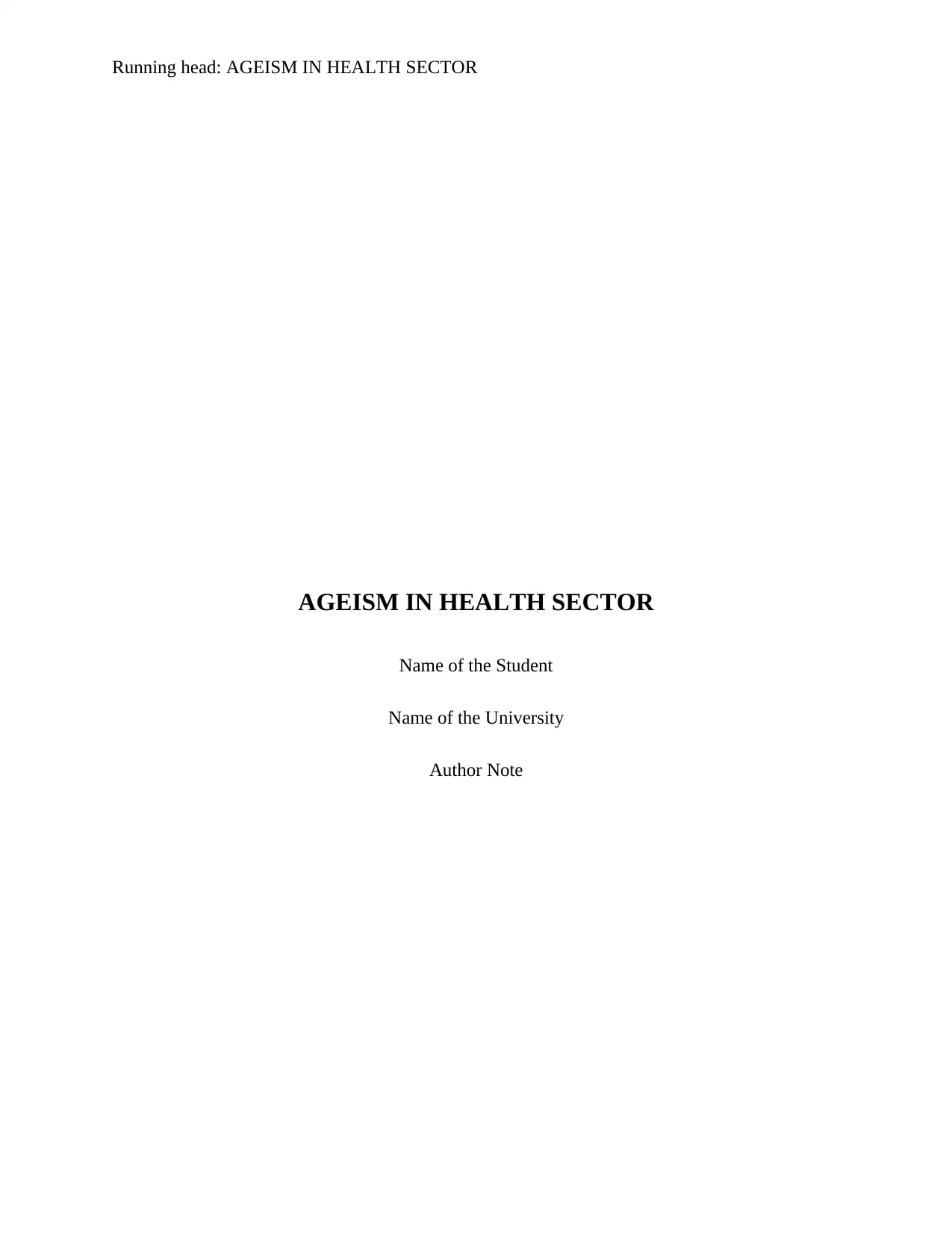
Running head: AGEISM IN HEALTH SECTOR
AGEISM IN HEALTH SECTOR
Name of the Student
Name of the University
Author Note
AGEISM IN HEALTH SECTOR
Name of the Student
Name of the University
Author Note
Paraphrase This Document
Need a fresh take? Get an instant paraphrase of this document with our AI Paraphraser
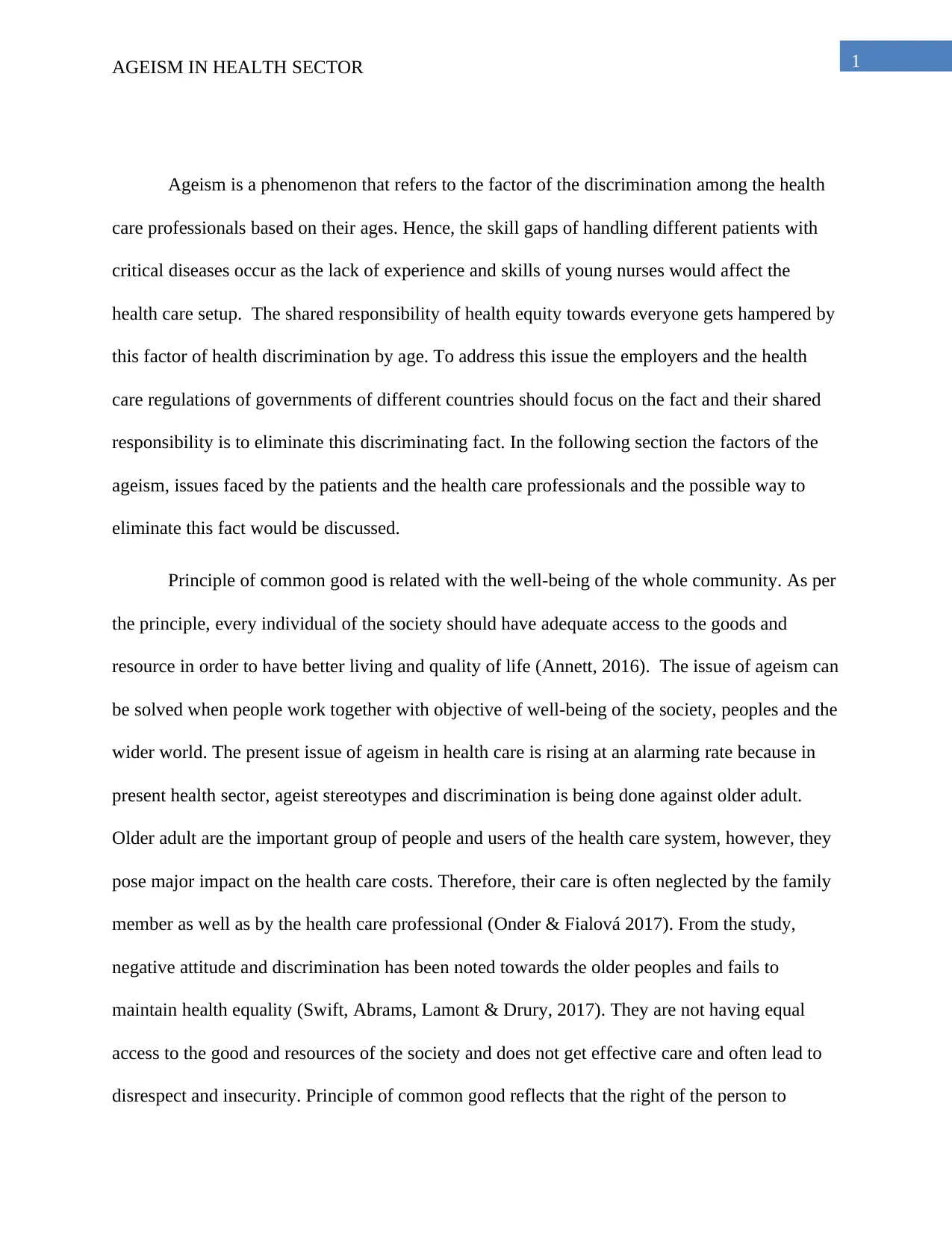
1AGEISM IN HEALTH SECTOR
Ageism is a phenomenon that refers to the factor of the discrimination among the health
care professionals based on their ages. Hence, the skill gaps of handling different patients with
critical diseases occur as the lack of experience and skills of young nurses would affect the
health care setup. The shared responsibility of health equity towards everyone gets hampered by
this factor of health discrimination by age. To address this issue the employers and the health
care regulations of governments of different countries should focus on the fact and their shared
responsibility is to eliminate this discriminating fact. In the following section the factors of the
ageism, issues faced by the patients and the health care professionals and the possible way to
eliminate this fact would be discussed.
Principle of common good is related with the well-being of the whole community. As per
the principle, every individual of the society should have adequate access to the goods and
resource in order to have better living and quality of life (Annett, 2016). The issue of ageism can
be solved when people work together with objective of well-being of the society, peoples and the
wider world. The present issue of ageism in health care is rising at an alarming rate because in
present health sector, ageist stereotypes and discrimination is being done against older adult.
Older adult are the important group of people and users of the health care system, however, they
pose major impact on the health care costs. Therefore, their care is often neglected by the family
member as well as by the health care professional (Onder & Fialová 2017). From the study,
negative attitude and discrimination has been noted towards the older peoples and fails to
maintain health equality (Swift, Abrams, Lamont & Drury, 2017). They are not having equal
access to the good and resources of the society and does not get effective care and often lead to
disrespect and insecurity. Principle of common good reflects that the right of the person to
Ageism is a phenomenon that refers to the factor of the discrimination among the health
care professionals based on their ages. Hence, the skill gaps of handling different patients with
critical diseases occur as the lack of experience and skills of young nurses would affect the
health care setup. The shared responsibility of health equity towards everyone gets hampered by
this factor of health discrimination by age. To address this issue the employers and the health
care regulations of governments of different countries should focus on the fact and their shared
responsibility is to eliminate this discriminating fact. In the following section the factors of the
ageism, issues faced by the patients and the health care professionals and the possible way to
eliminate this fact would be discussed.
Principle of common good is related with the well-being of the whole community. As per
the principle, every individual of the society should have adequate access to the goods and
resource in order to have better living and quality of life (Annett, 2016). The issue of ageism can
be solved when people work together with objective of well-being of the society, peoples and the
wider world. The present issue of ageism in health care is rising at an alarming rate because in
present health sector, ageist stereotypes and discrimination is being done against older adult.
Older adult are the important group of people and users of the health care system, however, they
pose major impact on the health care costs. Therefore, their care is often neglected by the family
member as well as by the health care professional (Onder & Fialová 2017). From the study,
negative attitude and discrimination has been noted towards the older peoples and fails to
maintain health equality (Swift, Abrams, Lamont & Drury, 2017). They are not having equal
access to the good and resources of the society and does not get effective care and often lead to
disrespect and insecurity. Principle of common good reflects that the right of the person to
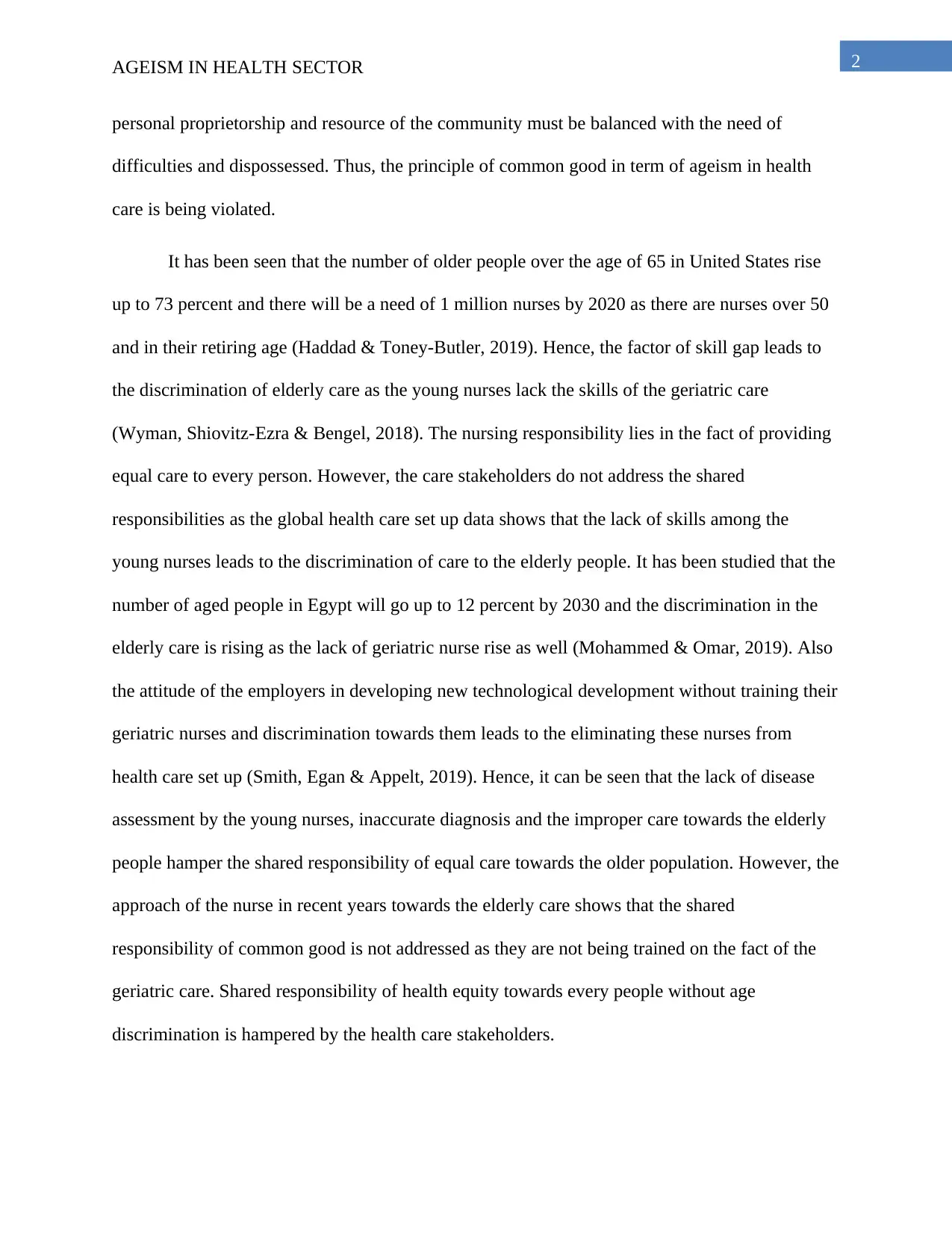
2AGEISM IN HEALTH SECTOR
personal proprietorship and resource of the community must be balanced with the need of
difficulties and dispossessed. Thus, the principle of common good in term of ageism in health
care is being violated.
It has been seen that the number of older people over the age of 65 in United States rise
up to 73 percent and there will be a need of 1 million nurses by 2020 as there are nurses over 50
and in their retiring age (Haddad & Toney-Butler, 2019). Hence, the factor of skill gap leads to
the discrimination of elderly care as the young nurses lack the skills of the geriatric care
(Wyman, Shiovitz-Ezra & Bengel, 2018). The nursing responsibility lies in the fact of providing
equal care to every person. However, the care stakeholders do not address the shared
responsibilities as the global health care set up data shows that the lack of skills among the
young nurses leads to the discrimination of care to the elderly people. It has been studied that the
number of aged people in Egypt will go up to 12 percent by 2030 and the discrimination in the
elderly care is rising as the lack of geriatric nurse rise as well (Mohammed & Omar, 2019). Also
the attitude of the employers in developing new technological development without training their
geriatric nurses and discrimination towards them leads to the eliminating these nurses from
health care set up (Smith, Egan & Appelt, 2019). Hence, it can be seen that the lack of disease
assessment by the young nurses, inaccurate diagnosis and the improper care towards the elderly
people hamper the shared responsibility of equal care towards the older population. However, the
approach of the nurse in recent years towards the elderly care shows that the shared
responsibility of common good is not addressed as they are not being trained on the fact of the
geriatric care. Shared responsibility of health equity towards every people without age
discrimination is hampered by the health care stakeholders.
personal proprietorship and resource of the community must be balanced with the need of
difficulties and dispossessed. Thus, the principle of common good in term of ageism in health
care is being violated.
It has been seen that the number of older people over the age of 65 in United States rise
up to 73 percent and there will be a need of 1 million nurses by 2020 as there are nurses over 50
and in their retiring age (Haddad & Toney-Butler, 2019). Hence, the factor of skill gap leads to
the discrimination of elderly care as the young nurses lack the skills of the geriatric care
(Wyman, Shiovitz-Ezra & Bengel, 2018). The nursing responsibility lies in the fact of providing
equal care to every person. However, the care stakeholders do not address the shared
responsibilities as the global health care set up data shows that the lack of skills among the
young nurses leads to the discrimination of care to the elderly people. It has been studied that the
number of aged people in Egypt will go up to 12 percent by 2030 and the discrimination in the
elderly care is rising as the lack of geriatric nurse rise as well (Mohammed & Omar, 2019). Also
the attitude of the employers in developing new technological development without training their
geriatric nurses and discrimination towards them leads to the eliminating these nurses from
health care set up (Smith, Egan & Appelt, 2019). Hence, it can be seen that the lack of disease
assessment by the young nurses, inaccurate diagnosis and the improper care towards the elderly
people hamper the shared responsibility of equal care towards the older population. However, the
approach of the nurse in recent years towards the elderly care shows that the shared
responsibility of common good is not addressed as they are not being trained on the fact of the
geriatric care. Shared responsibility of health equity towards every people without age
discrimination is hampered by the health care stakeholders.
⊘ This is a preview!⊘
Do you want full access?
Subscribe today to unlock all pages.

Trusted by 1+ million students worldwide
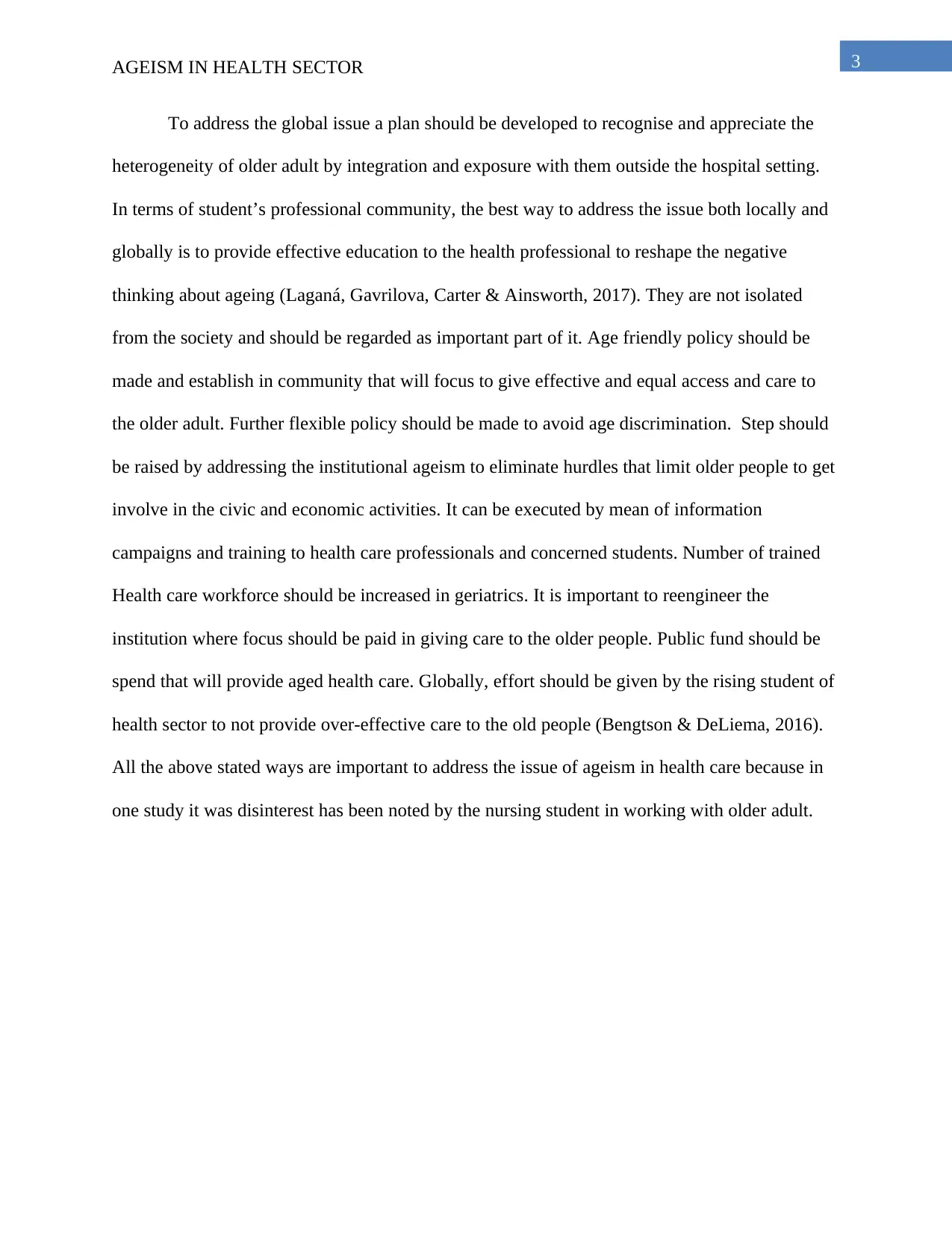
3AGEISM IN HEALTH SECTOR
To address the global issue a plan should be developed to recognise and appreciate the
heterogeneity of older adult by integration and exposure with them outside the hospital setting.
In terms of student’s professional community, the best way to address the issue both locally and
globally is to provide effective education to the health professional to reshape the negative
thinking about ageing (Laganá, Gavrilova, Carter & Ainsworth, 2017). They are not isolated
from the society and should be regarded as important part of it. Age friendly policy should be
made and establish in community that will focus to give effective and equal access and care to
the older adult. Further flexible policy should be made to avoid age discrimination. Step should
be raised by addressing the institutional ageism to eliminate hurdles that limit older people to get
involve in the civic and economic activities. It can be executed by mean of information
campaigns and training to health care professionals and concerned students. Number of trained
Health care workforce should be increased in geriatrics. It is important to reengineer the
institution where focus should be paid in giving care to the older people. Public fund should be
spend that will provide aged health care. Globally, effort should be given by the rising student of
health sector to not provide over-effective care to the old people (Bengtson & DeLiema, 2016).
All the above stated ways are important to address the issue of ageism in health care because in
one study it was disinterest has been noted by the nursing student in working with older adult.
To address the global issue a plan should be developed to recognise and appreciate the
heterogeneity of older adult by integration and exposure with them outside the hospital setting.
In terms of student’s professional community, the best way to address the issue both locally and
globally is to provide effective education to the health professional to reshape the negative
thinking about ageing (Laganá, Gavrilova, Carter & Ainsworth, 2017). They are not isolated
from the society and should be regarded as important part of it. Age friendly policy should be
made and establish in community that will focus to give effective and equal access and care to
the older adult. Further flexible policy should be made to avoid age discrimination. Step should
be raised by addressing the institutional ageism to eliminate hurdles that limit older people to get
involve in the civic and economic activities. It can be executed by mean of information
campaigns and training to health care professionals and concerned students. Number of trained
Health care workforce should be increased in geriatrics. It is important to reengineer the
institution where focus should be paid in giving care to the older people. Public fund should be
spend that will provide aged health care. Globally, effort should be given by the rising student of
health sector to not provide over-effective care to the old people (Bengtson & DeLiema, 2016).
All the above stated ways are important to address the issue of ageism in health care because in
one study it was disinterest has been noted by the nursing student in working with older adult.
Paraphrase This Document
Need a fresh take? Get an instant paraphrase of this document with our AI Paraphraser
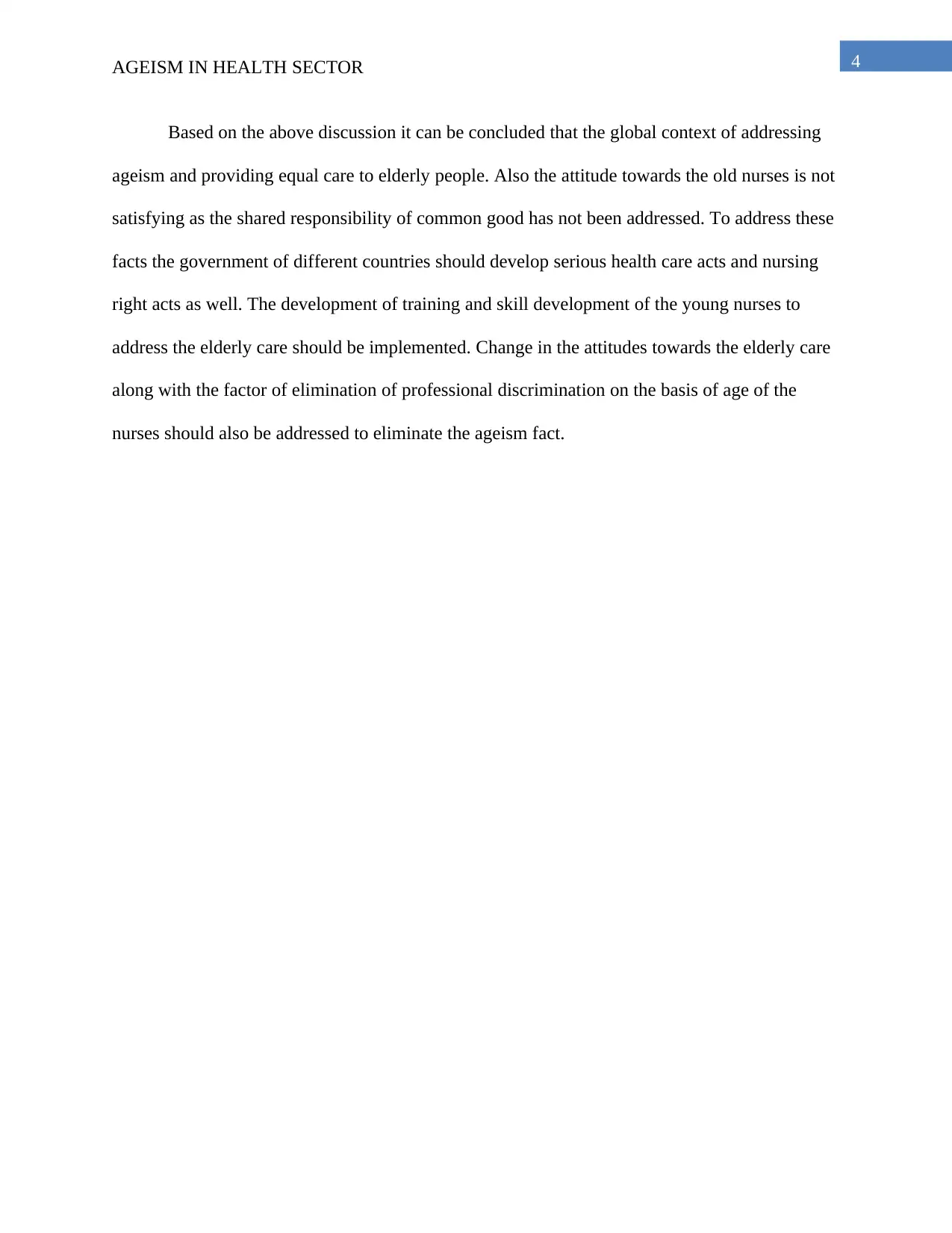
4AGEISM IN HEALTH SECTOR
Based on the above discussion it can be concluded that the global context of addressing
ageism and providing equal care to elderly people. Also the attitude towards the old nurses is not
satisfying as the shared responsibility of common good has not been addressed. To address these
facts the government of different countries should develop serious health care acts and nursing
right acts as well. The development of training and skill development of the young nurses to
address the elderly care should be implemented. Change in the attitudes towards the elderly care
along with the factor of elimination of professional discrimination on the basis of age of the
nurses should also be addressed to eliminate the ageism fact.
Based on the above discussion it can be concluded that the global context of addressing
ageism and providing equal care to elderly people. Also the attitude towards the old nurses is not
satisfying as the shared responsibility of common good has not been addressed. To address these
facts the government of different countries should develop serious health care acts and nursing
right acts as well. The development of training and skill development of the young nurses to
address the elderly care should be implemented. Change in the attitudes towards the elderly care
along with the factor of elimination of professional discrimination on the basis of age of the
nurses should also be addressed to eliminate the ageism fact.
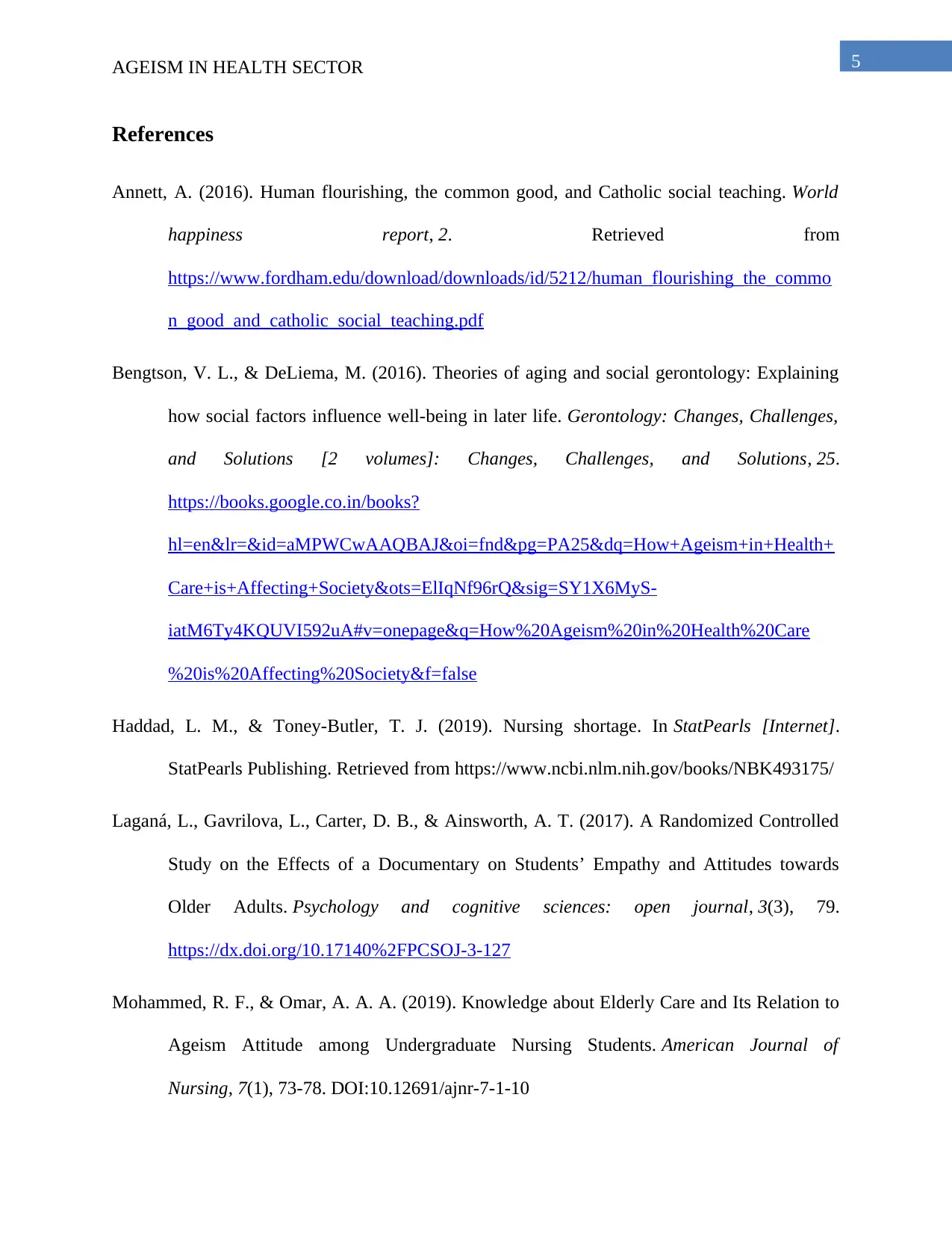
5AGEISM IN HEALTH SECTOR
References
Annett, A. (2016). Human flourishing, the common good, and Catholic social teaching. World
happiness report, 2. Retrieved from
https://www.fordham.edu/download/downloads/id/5212/human_flourishing_the_commo
n_good_and_catholic_social_teaching.pdf
Bengtson, V. L., & DeLiema, M. (2016). Theories of aging and social gerontology: Explaining
how social factors influence well-being in later life. Gerontology: Changes, Challenges,
and Solutions [2 volumes]: Changes, Challenges, and Solutions, 25.
https://books.google.co.in/books?
hl=en&lr=&id=aMPWCwAAQBAJ&oi=fnd&pg=PA25&dq=How+Ageism+in+Health+
Care+is+Affecting+Society&ots=ElIqNf96rQ&sig=SY1X6MyS-
iatM6Ty4KQUVI592uA#v=onepage&q=How%20Ageism%20in%20Health%20Care
%20is%20Affecting%20Society&f=false
Haddad, L. M., & Toney-Butler, T. J. (2019). Nursing shortage. In StatPearls [Internet].
StatPearls Publishing. Retrieved from https://www.ncbi.nlm.nih.gov/books/NBK493175/
Laganá, L., Gavrilova, L., Carter, D. B., & Ainsworth, A. T. (2017). A Randomized Controlled
Study on the Effects of a Documentary on Students’ Empathy and Attitudes towards
Older Adults. Psychology and cognitive sciences: open journal, 3(3), 79.
https://dx.doi.org/10.17140%2FPCSOJ-3-127
Mohammed, R. F., & Omar, A. A. A. (2019). Knowledge about Elderly Care and Its Relation to
Ageism Attitude among Undergraduate Nursing Students. American Journal of
Nursing, 7(1), 73-78. DOI:10.12691/ajnr-7-1-10
References
Annett, A. (2016). Human flourishing, the common good, and Catholic social teaching. World
happiness report, 2. Retrieved from
https://www.fordham.edu/download/downloads/id/5212/human_flourishing_the_commo
n_good_and_catholic_social_teaching.pdf
Bengtson, V. L., & DeLiema, M. (2016). Theories of aging and social gerontology: Explaining
how social factors influence well-being in later life. Gerontology: Changes, Challenges,
and Solutions [2 volumes]: Changes, Challenges, and Solutions, 25.
https://books.google.co.in/books?
hl=en&lr=&id=aMPWCwAAQBAJ&oi=fnd&pg=PA25&dq=How+Ageism+in+Health+
Care+is+Affecting+Society&ots=ElIqNf96rQ&sig=SY1X6MyS-
iatM6Ty4KQUVI592uA#v=onepage&q=How%20Ageism%20in%20Health%20Care
%20is%20Affecting%20Society&f=false
Haddad, L. M., & Toney-Butler, T. J. (2019). Nursing shortage. In StatPearls [Internet].
StatPearls Publishing. Retrieved from https://www.ncbi.nlm.nih.gov/books/NBK493175/
Laganá, L., Gavrilova, L., Carter, D. B., & Ainsworth, A. T. (2017). A Randomized Controlled
Study on the Effects of a Documentary on Students’ Empathy and Attitudes towards
Older Adults. Psychology and cognitive sciences: open journal, 3(3), 79.
https://dx.doi.org/10.17140%2FPCSOJ-3-127
Mohammed, R. F., & Omar, A. A. A. (2019). Knowledge about Elderly Care and Its Relation to
Ageism Attitude among Undergraduate Nursing Students. American Journal of
Nursing, 7(1), 73-78. DOI:10.12691/ajnr-7-1-10
⊘ This is a preview!⊘
Do you want full access?
Subscribe today to unlock all pages.

Trusted by 1+ million students worldwide
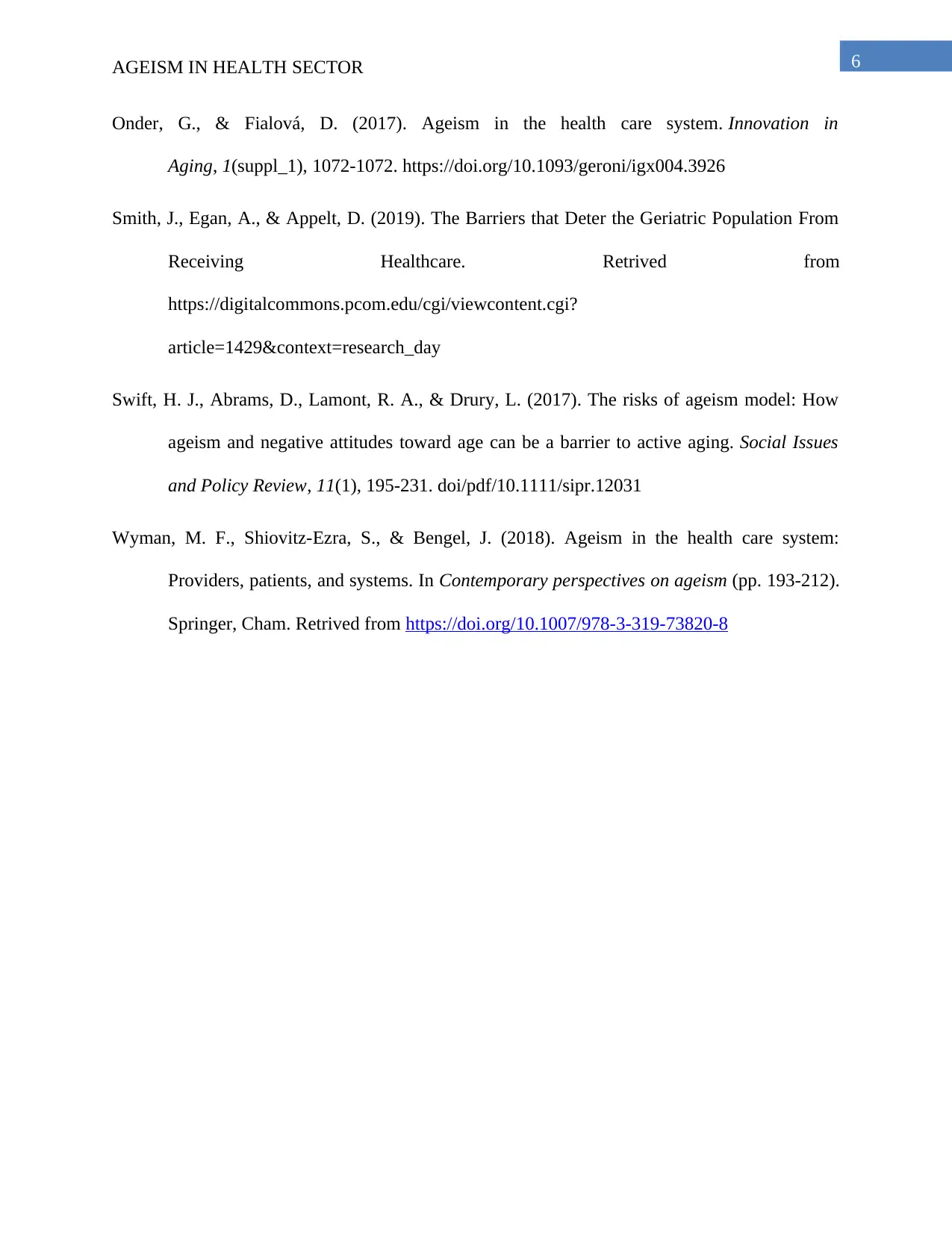
6AGEISM IN HEALTH SECTOR
Onder, G., & Fialová, D. (2017). Ageism in the health care system. Innovation in
Aging, 1(suppl_1), 1072-1072. https://doi.org/10.1093/geroni/igx004.3926
Smith, J., Egan, A., & Appelt, D. (2019). The Barriers that Deter the Geriatric Population From
Receiving Healthcare. Retrived from
https://digitalcommons.pcom.edu/cgi/viewcontent.cgi?
article=1429&context=research_day
Swift, H. J., Abrams, D., Lamont, R. A., & Drury, L. (2017). The risks of ageism model: How
ageism and negative attitudes toward age can be a barrier to active aging. Social Issues
and Policy Review, 11(1), 195-231. doi/pdf/10.1111/sipr.12031
Wyman, M. F., Shiovitz-Ezra, S., & Bengel, J. (2018). Ageism in the health care system:
Providers, patients, and systems. In Contemporary perspectives on ageism (pp. 193-212).
Springer, Cham. Retrived from https://doi.org/10.1007/978-3-319-73820-8
Onder, G., & Fialová, D. (2017). Ageism in the health care system. Innovation in
Aging, 1(suppl_1), 1072-1072. https://doi.org/10.1093/geroni/igx004.3926
Smith, J., Egan, A., & Appelt, D. (2019). The Barriers that Deter the Geriatric Population From
Receiving Healthcare. Retrived from
https://digitalcommons.pcom.edu/cgi/viewcontent.cgi?
article=1429&context=research_day
Swift, H. J., Abrams, D., Lamont, R. A., & Drury, L. (2017). The risks of ageism model: How
ageism and negative attitudes toward age can be a barrier to active aging. Social Issues
and Policy Review, 11(1), 195-231. doi/pdf/10.1111/sipr.12031
Wyman, M. F., Shiovitz-Ezra, S., & Bengel, J. (2018). Ageism in the health care system:
Providers, patients, and systems. In Contemporary perspectives on ageism (pp. 193-212).
Springer, Cham. Retrived from https://doi.org/10.1007/978-3-319-73820-8
1 out of 7
Related Documents
Your All-in-One AI-Powered Toolkit for Academic Success.
+13062052269
info@desklib.com
Available 24*7 on WhatsApp / Email
![[object Object]](/_next/static/media/star-bottom.7253800d.svg)
Unlock your academic potential
Copyright © 2020–2025 A2Z Services. All Rights Reserved. Developed and managed by ZUCOL.





